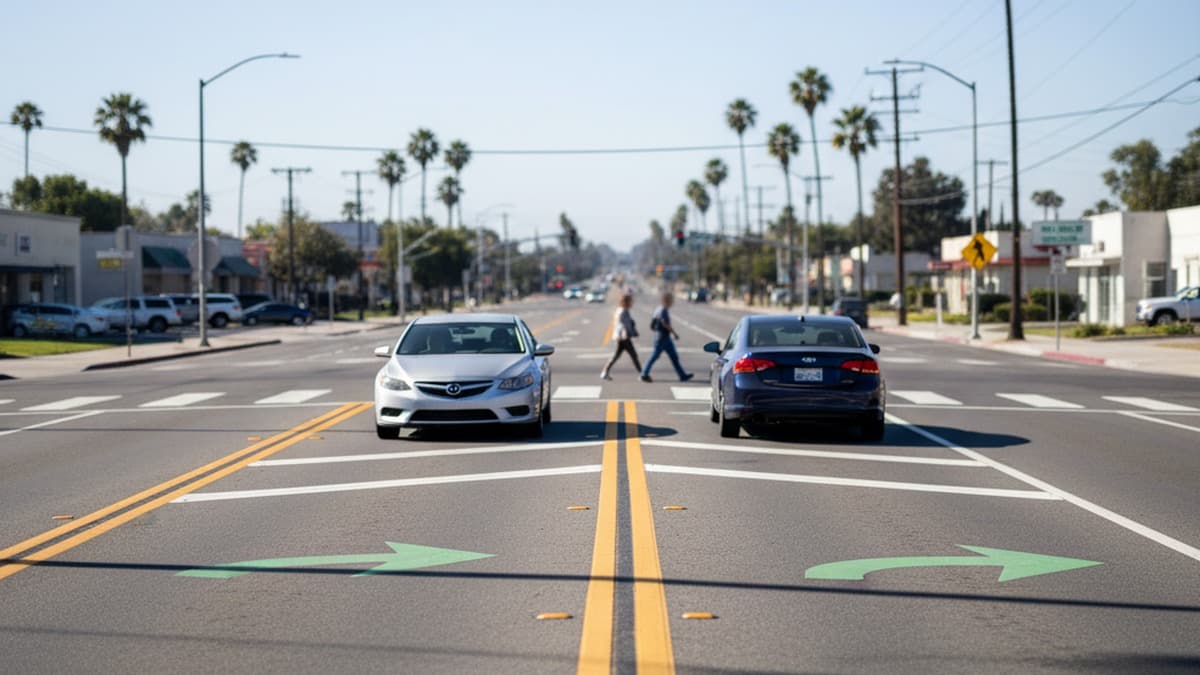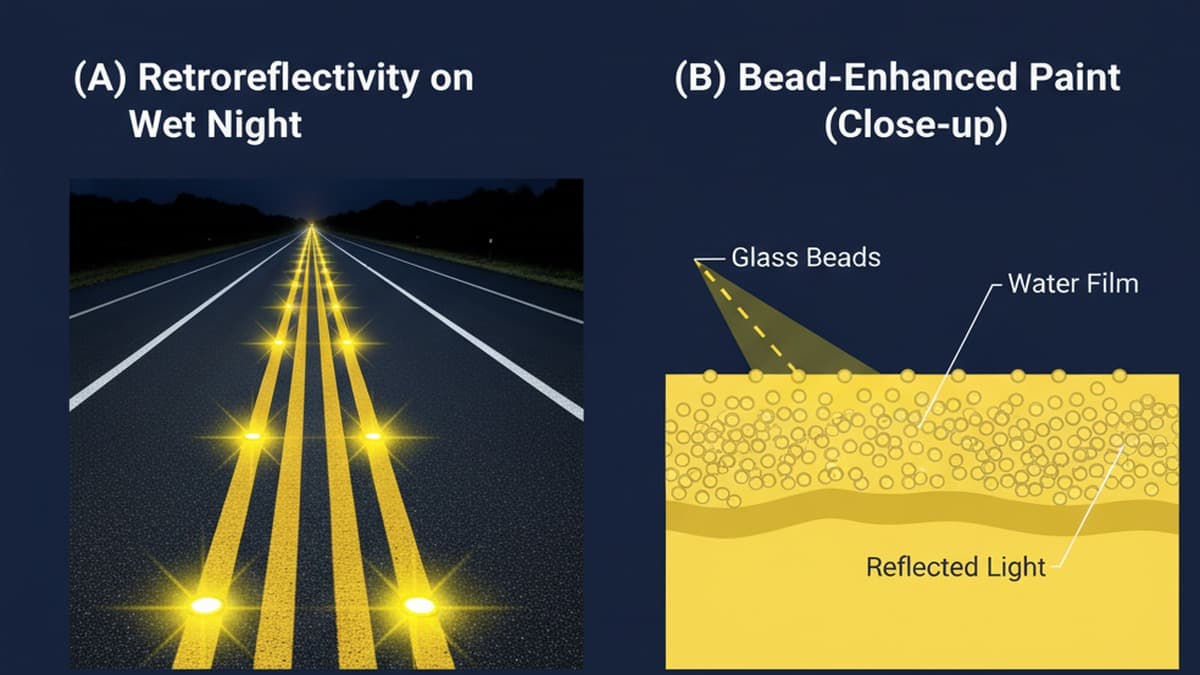Drivers across the U.S. often ask a deceptively simple question: when I see two sets of double yellow lines (sometimes called a double-double yellow), is that a painted median barrier I can never cross—or are there situations where a left turn or U-turn is still lawful? This guide explains how agencies use the double-double pattern, why it's treated like a median, where legal openings exist, how tickets are enforced, and what to watch for at night when visibility drops. We'll reference California's well-known rules and show how other states apply the same engineering logic.

Why agencies paint double-double yellow medians
A double-double yellow is a pair of closely spaced double yellow centerlines that form a painted median. Transportation agencies deploy it where a raised island would be helpful but impractical—think arterial corridors with long stretches of driveways, frequent mid-block crashes, or constrained cross-sections. The intent is to create a no-man's-land drivers must not enter, except through a specifically designed opening.
Double-double yellow = painted median barrier
In plain language, don't drive on or across the painted median. It functions like a physical separator. The double-double discourages risky mid-block turns that cause angle crashes and rear-end conflicts. Entering that zone—whether to shortcut a left into a driveway or to make a U-turn where no opening exists—nearly always results in a citation.
California update: CVC & engineering notes
California popularized the term "double-double." The CVC guidance and local engineering practice treat it as a median barrier. You may use it only at designated breaks. Elsewhere, it's legally the same as a no-crossing zone. Other states mirror this approach through their traffic manuals and statutes.
Typical "no crossing / no U-turn" use cases
- Corridors with high left-turn crash rates and insufficient width for a raised island.
- Busy suburban arterials with many driveways where ad-hoc mid-block turns create conflicts.
- Approaches to major intersections where queue jumps and late U-turns must be prevented.
When a work-zone flagger overrides the lines
During temporary traffic control, a flagger's instruction or lane shift may override normal markings. If a crew directs you across the median area, it's lawful for that moment. Otherwise, assume the painted median is off-limits.
Safety benefits on undivided multi-lane roads
The double-double improves gap discipline, reduces surprise mid-block entries, and provides visual separation that calms turning behavior. Crash studies show reductions in left-turn and head-on collisions after converting a simple double yellow to a painted median barrier.
Driveway density and mid-block conflict points
Where driveways are frequent, nearly every unsignalized left turn from the major street becomes a conflict point. A double-double funnels those movements to planned openings that have better sight distance and fewer surprises for through traffic.
Speed + volume = where agencies choose medians
Agencies weigh corridor speed, traffic volume, and crash patterns. Above certain thresholds, the safest answer is a median—painted or raised—to keep turning vehicles out of the through lanes except at designed spots.
Why raised islands aren't always installed
Raised islands cost more, complicate drainage and plowing, and can hinder emergency maneuvers. The painted median is a quick, cost-effective countermeasure that still delivers most safety benefits.
Finding legal openings and avoiding illegal crossings
You can cross a double-double only at a legal opening. These gaps are intentional: they concentrate turning traffic into predictable, controlled locations and are often paired with signage or auxiliary turn lanes.
Where openings exist and how to read them
Look for a break in the inner lines with either a left-turn pocket or a short hatched neutral area. Callouts and arrows guide you through. If you don't see a gap, keep going—there should be another opening ahead at a safer location.
Markings you should see at a legal opening
- Left-turn pocket with center-turn-lane arrows or a short channelized bay.
- Hatched neutral area tapering into the opening; sometimes reflective markers at night.
- Supplemental signs for driveways, median crossings, or posted U-turn permissions.
Turn pockets, arrows, and cross-street control
Openings near signals may include protection (green arrows). Mid-block gaps rely on yield rules and sight distance. Always signal early and commit only when both directions are clear.
Nighttime visibility at openings vs. closed sections
Openings typically feature added contrast or retroreflective raised pavement markers (RPMs). If you can't clearly identify a break at night or in rain, assume it's closed and continue to a signalized intersection.

What not to do at solid double-double segments
Drivers sometimes "nose" into the median to shortcut a left into a driveway or to force a U-turn. That's the behavior the double-double was designed to prevent—and it's exactly what triggers tickets.
Left-turns across the median vs. designated gaps
If the median is solid through your location, your left turn is prohibited. Proceed to the next opening or intersection with a permitted movement. This is particularly strict in California and mirrors practice in many states.
U-turn rules and minimum sight distance
Even at legal openings, U-turns require ample sight distance and no posted prohibitions. If visibility is limited (night, rain, vertical curves), defer to a protected turn at a signal. See our U-turn explainer and state pages for specifics.
Obstruction avoidance: "only as far as necessary"
If a fallen branch or crash blocks your lane, some states allow crossing centerlines only as far as necessary to pass the obstruction and then immediately return. This is not a license to use the median for routine turning. Learn the boundary conditions in this guide.
Tickets, penalties, and how they're enforced
Because a double-double acts as a median barrier, crossing it without an opening is enforced similarly to crossing a raised island. Citations usually name the relevant state statute or local code that prohibits driving on a painted median or entering a restricted area.
Median barrier tickets and common defenses
Common defenses fail when video shows no opening. The strongest arguments relate to obstruction avoidance, confusing or faded markings, or directed by a flagger. Courts look for evidence: dashcam, photos of the site, and documentation of temporary traffic control.
Signage, line type, and record-keeping
If a corridor recently switched from a center left-turn lane to a double-double, defense may hinge on whether signs and RPMs were installed per plan. Agencies keep work orders and striping logs; ask for them if you're contesting a citation.
Camera or officer? Practical evidence tips
- Gather time-stamped photos or dashcam that show there was no opening at the movement.
- Document weather and night conditions if visibility was degraded.
- Note any conflicting devices (e.g., temporary cones) that might have implied a gap.
Verify with CA and other state sources
For background, see our California explainer at /state/ca/double-yellow/ and the concept summary /two-sets-of-double-yellow/. Many states echo the same rule set.
Nighttime visibility, reflectivity, and maintenance
Nighttime visibility matters because misreading a median can be catastrophic. Agencies combine retroreflective paint beads with RPMs to make the double-double pop at night and in the wet.
Nighttime visibility double-double best practices
Slow down, scan for RPM patterns, and anticipate openings near intersections. If the markings look continuous but you're unsure, treat them as closed and continue to a signal.
RPMs, contrast, and wet-night performance
RPMs create a dotted glow that mirrors the paint pattern. On wet pavement, high-build contrast or wet-night optics help. If you see broken inner lines and a taper, you're approaching a legal opening.
When fading paint creates ambiguity
If the median is severely worn, agencies expect drivers to follow the remaining pattern and default to caution. Report locations with poor visibility to the responsible road agency.
Reporting maintenance issues the right way
Note milepost/cross street, direction, and a photo. Most DOTs and cities have online request portals. Accurate reports accelerate restriping and RPM replacement.
FAQ — two sets of double yellow lines
Is a double-double yellow always a no-crossing median?
Yes—except where a designed opening exists or when lawfully directed in a work zone. Otherwise treat it like a median barrier.
How do I spot legal openings?
Look for a clear break in the inner lines, hatched neutral area, and usually a left-turn pocket or arrows. If you don't see a gap, it's closed.
Can I make a U-turn through a double-double?
Only at a permitted opening and with adequate sight distance. If a sign bans U-turns, obey it even at a gap.
What about crossing to avoid debris?
Some states allow a brief encroachment only as far as necessary to bypass an obstruction and return immediately. See our overview on limited obstruction avoidance: crossing a double solid yellow.